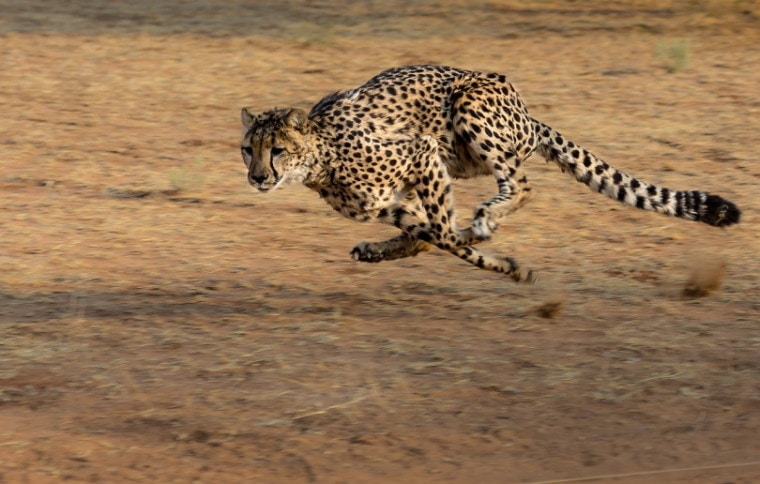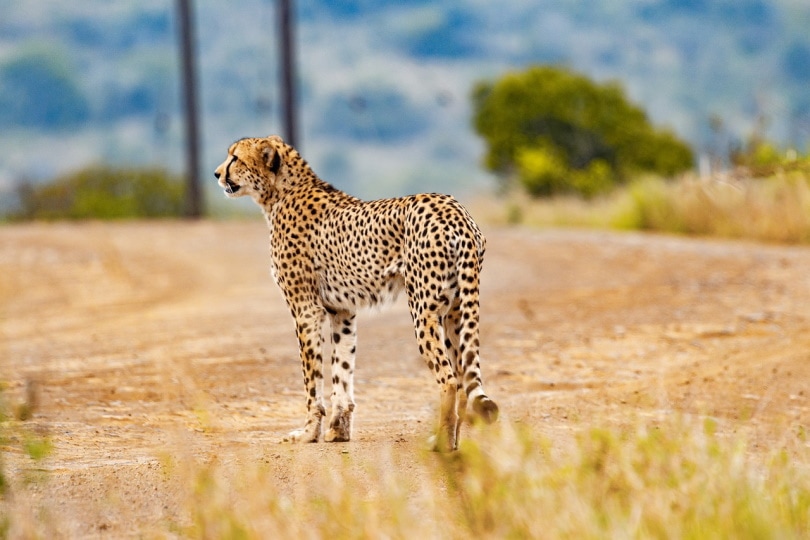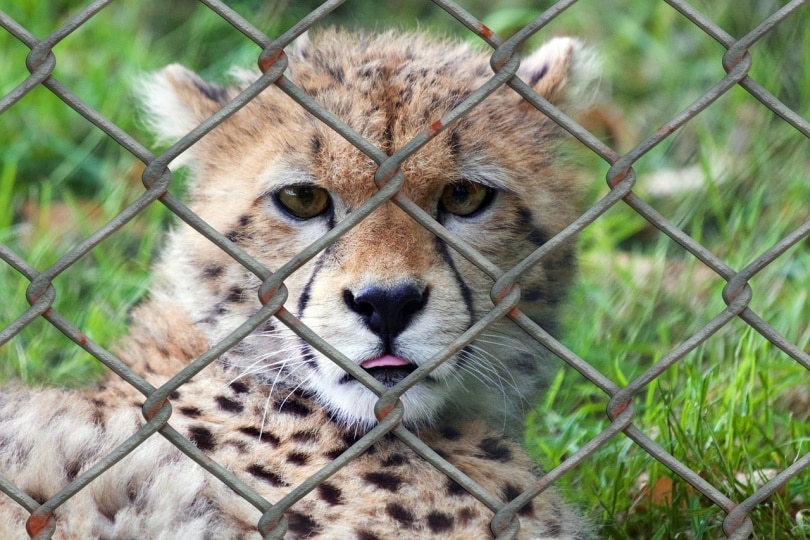
Disclaimer: We do not endorse keeping these animals as pets
Cheetahs are not only the fastest land mammals in the world, but they are also magnificent, graceful, and agile felines. Moreover, they are not as dangerous to humans as lions or tigers can be. But does that make them good pets? In a nutshell: no, cheetahs don’t make good pets at all and we do not endorse keeping them as such.
Why? Because although they are generally considered more docile than other big cats, cheetahs are primarily wild animals. This means they have very specific needs that are difficult to uphold when held in captivity, despite all your goodwill. It is also worth considering the ethical side of keeping such a feline as a pet.
Who Keeps Pet Cheetahs?

In the Gulf countries, the latest fad is not to have a luxury car or a heavenly villa. Instead, it is to have a pet feline. Not a cat, more like a cheetah, or even a tiger or a lion. In recent years, these animals have been multiplying in countries such as Qatar, Kuwait, the United Arab Emirates, or Saudi Arabia, and their owners no longer hesitate to expose themselves with their trophies on social networks. This is particularly the case for cheetahs, which are among the most sought-after felines.
Faced with this growing trend and the associated risks, several countries have decided to ban the keeping, sale, and reproduction of exotic animals under pressure from animal protection groups. In the United Arab Emirates, the law was passed in January 2017, mentioning fines of up to $136,000 and sentences of up to 6 months in prison. In Kuwait, the keeping of exotic animals is also prohibited.
Nevertheless, controls remain rare, convictions are long overdue, and fashion persists among the richest.
Why Keeping a Cheetah As a Pet Is a Bad Idea
1. The population of wild cheetahs is in continuous decline.
The cheetah is on the Red List of the International Union for the Conservation of Nature (IUCN) under the vulnerable category, as roughly 6,700 mature individuals remain in the wild. Poaching is not the only threat to the species, which also suffers from conflict with humans—the cheetah is still often seen as a nuisance—and the destruction of its habitat. Formerly widespread in Africa and West Asia, the cheetah has disappeared from many countries such as India, Morocco, and Nigeria.
In Asia, the only country where you can still find cheetahs is Iran. In Africa, the main populations are found in Namibia, Botswana, and Zimbabwe. In addition, declining populations and habitat loss have exposed the cheetah to a more pernicious threat—inbreeding. Thus, over the centuries, reproduction between related individuals has further weakened the species’ genetic heritage, making it more vulnerable.

2. Cheetahs have very special dietary needs.
Like the majority of wild animals kept as pets, cheetahs are often fed and cared for inappropriately.
In general, people who wish to acquire a cheetah have very little knowledge of their dietary needs. This feline is not made to eat raw poultry all day long! Besides, these inadequate diets cause significant health problems, such as myelopathy (paralysis of the hind limbs) and spinal cord degeneration.
3. Cheetahs require specific holding facilities.
Cheetahs need huge holding facilities to keep them healthy. These felines are biologically made to run, not to be kept on a leash and confined in small spaces where their physical activity is almost zero.
4. Many baby cheetahs die before they even reach their destination.
According to the NGO Cheetah Conservation Fund (CCF) estimates, some 300 baby cheetahs are smuggled each year to the Arabian Peninsula to be sold as pets. While these numbers may seem modest compared to the tens of thousands of elephants slaughtered each year, they are actually dramatic for the cheetah population.
Indeed, the cheetah traffic leaves a lot of corpses on its way. Baby cheetahs can be stolen when they are two weeks old, and in these cases, they will either not survive the trip, or they will suffer from chronic conditions later because they were deprived of breast milk. From the moment they are taken from the wild, the risk is there because they will not live in natural conditions nor receive the food they need. And cheetahs are very fragile; their health can deteriorate quickly to death within hours.
Even if they survive the travel conditions, despite the lack of food and water, and make it onto the market, their life expectancy will depend on their owner. Many cheetahs die after a few months, and the average life expectancy is one year. Many end up with bone deformities, neurological degenerations, or die from viruses they have caught from domestic cats.

5. Cheetahs are sold at exorbitant prices.
The sale of pet cheetahs is particularly lucrative. Buyers are willing to pay up to $15,000 to acquire one of these luxury pets. But, like mentioned before, about 80% of baby cheetahs die in the process. In fact, it is estimated that five out of six baby cheetahs do not survive the trip. Knowing this data, who would be willing to buy a cheetah and contribute to the illegal trafficking that kills dozens, if not hundreds, of defenseless animals every year?
6. Cheetahs in captivity are more affected by disease than their wild counterparts.
Some people may wish to adopt cheetahs for the purpose of participating in breed conservation efforts, mistakenly believing that a cheetah kept in captivity will be “protected” from the dangers encountered in its wild habitat. Unfortunately, cheetahs kept in captivity are more likely to suffer from various illnesses. Indeed, these felines are more susceptible to diseases than other large carnivores, even when kept in wildlife conservation centers, where their living conditions are generally optimal and where they are cared for by biologists and veterinarians.
Diseases that commonly affect cheetahs in captivity are:
Most studies suggest that environmental factors, such as captive-induced stress, are of equal or greater importance than genetic factors in the development of diseases in captive cheetahs.
The bottom line? Cheetahs are creatures with more fragile health than their other feline cousins. Therefore, keeping them in captivity does not usually help their survival; it is quite the contrary.

- Related article: Cheetah Support Dogs – The Amazing Relationship Explained
Final Thoughts
In a century, the world’s population has fallen from 100,000 cheetahs to less than 6,700 today. It is estimated that only a few hundred individuals remain in parts of East Africa, such as Ethiopia or Northern Kenya. Unfortunately, these areas are among the most affected by the illegal pet cheetah trade, which has now grown into large-scale trafficking. Therefore, keeping these beautiful felines in a backyard puts the species even more at risk. However, if you want to participate in cheetah conservation efforts, volunteering at a wildlife center could be a great way to get closer to and help these magnificent creatures.
Looking for other potential pet options? Try:
Featured Image Credit: DrZoltan, Pixabay







